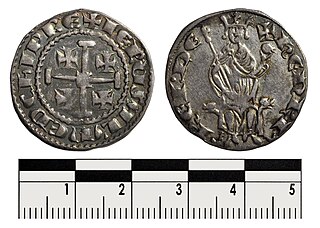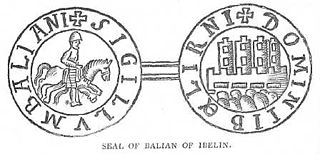Related Research Articles
Hugh III, also called Hugh of Antioch-Lusignan and the Great, was the king of Cyprus from 1267 and king of Jerusalem from 1268. Born into the family of the princes of Antioch, he effectively ruled as regent for underage kings Hugh II of Cyprus and Conrad III of Jerusalem for several years. Prevailing over the claims of his cousin Hugh of Brienne, he succeeded both young monarchs upon their deaths and appeared poised to be an effective political and military leader.

The Kingdom of Jerusalem, one of the Crusader states that was created in 1099, was divided into a number of smaller seigneuries. According to the 13th-century jurist John of Ibelin, the four highest crown vassals in the kingdom proper were the count of Jaffa and Ascalon, the prince of Galilee, the lord of Sidon, and the lord of Oultrejordain.

Henry II was the last crowned King of Jerusalem and also ruled as King of Cyprus. He was of the Lusignan dynasty.

The House of Ibelin was a noble family in the Crusader Kingdom of Jerusalem in the 12th century. They rose from humble beginnings to become one of the most important families in the kingdom, holding various high offices and with extensive holdings in the Holy Land and Cyprus. The family disappeared after the fall of the Kingdom of Cyprus in the 15th century.
Baldwin of Ibelin, also known as Baldwin II of Ramla, was an important noble of the Kingdom of Jerusalem in the 12th century and was lord of Ramla from 1169-1186. He was the second son of Barisan of Ibelin, and was the younger brother of Hugh of Ibelin and older brother of Balian of Ibelin. He first appears in the historical record as a witness to charters in 1148.

Balian of Ibelin, also known as Barisan the Younger, was a crusader noble of the Kingdom of Jerusalem in the 12th century. He was lord of Ibelin from 1170 to 1193. As the leader of the defense of the city during the siege of Jerusalem in 1187, he surrendered Jerusalem to Saladin on 2 October 1187.
John of Ibelin, called the Old Lord of Beirut, was a powerful crusader noble in the 13th century, one of the best known representatives of the influential Ibelin family. The son of Balian of Ibelin and the dowager queen Maria Comnena, he had close ties with the nobility of both Cyprus and Jerusalem, since he was the half-brother of Queen Isabella I of Jerusalem. Before he was 20, he was appointed constable of Jerusalem, and a few years later became lord of Beirut. John rebuilt Beirut after Saladin's conquest, and established the grand Ibelin family palace. He served as regent of Jerusalem on behalf of his niece Maria of Montferrat from 1205 to 1210 after her mother, Queen Isabella, died. He was also regent for Isabella's grandson Henry I of Cyprus from 1228 until Henry came of age in 1232. John was known as a principled man, and was seen as the natural leader of the Christian barons in the Holy Land. He resisted the power-seeking of Frederick II, Holy Roman Emperor, in Cyprus, and opposed the imperial forces until King Henry came of age.

The principality of Galilee was one of the four major seigneuries of the crusader Kingdom of Jerusalem, according to 13th-century commentator John of Ibelin, grandson of Balian. The direct holdings of the principality centred around Tiberias, in Galilee proper, but with all its vassals, the lordship covered all Galilee and southern Phoenicia. The independent Lordship of Sidon was located between Galilee's holdings. The principality also had its own vassals: the Lordships of Beirut, Nazareth, and Haifa.
Amalric, Lord of Tyre, also called Amalric of Lusignan or Amaury de Lusignan was a prince and statesman of the House of Lusignan, a younger son of King Hugh III of Cyprus and Isabella of the House of Ibelin. He was given the title of Lord of Tyre in 1291, shortly before the city of Tyre fell to the Mamluks of Egypt. He is often but incorrectly called the Prince of Tyre.

Reginald Grenier was lord of Sidon and an important noble in the late-12th century Kingdom of Jerusalem.
John of Ibelin, often called John II, was the Lord of Beirut from 1254, named after his grandfather John I, the famous "Old Lord of Beirut", and son of Balian of Ibelin, who surrendered Jerusalem to Saladin in 1187. His parents were Balian of Beirut and Eschiva, daughter of Walter of Montbéliard and Burgundia of Cyprus.
Guy of Ibelin, of the Ibelin family, was count of Jaffa and Ascalon during the latter part of the Crusades. He was the son of John of Ibelin and Maria of Barbaron. He was count in name only. His father, John of Jaffa, had died in 1266, after which the fragile truce with the Muslims collapsed, and Jaffa was captured by Baibars in 1268. John was probably succeeded by Guy's older brother James, who held the title of Count of Jaffa until his death in 1276, at which point the title passed to Guy.
Humphrey of Montfort was a nobleman of the Kingdom of Jerusalem.
Eschive d'Ibelin (1253–1312) was suo jure Lady of Beirut in 1282–1312. She was the daughter of John II of Beirut, lord of Beirut, and of Alice de la Roche, and a member of the influential Ibelin family.

Guy of Ibelin was marshal and constable of the kingdom of Cyprus. He was the fifth son of John of Ibelin, the Old Lord of Beirut, and of Melisende of Arsuf. He had close relations with the king of Cyprus, Henry I, acting as witness for two royal decrees; he was probably one of the king's executors named in a papal bull of Pope Alexander IV. With his brother Baldwin of Ibelin, he led the Cypriot crusaders in the siege of Damietta in 1248. According to the medieval chronicler Jean de Joinville, he was one of the most accomplished knights of his generation and a benevolent ruler on Cyprus. Joinville recounts an episode when he, Guy and Baldwin had been taken prisoner by Saracen rebels:
I asked the lord Baldwin of Ibelin, who knew the saracen tongue well, what the men were saying. He answered that they were talking about cutting off our heads. Many men then made confession to a brother of the Holy Trinity, named John, belonging to the retinue of count William of Flanders. I could not think of a single sin. At the same time I was thinking that the more I defended myself the worse it would be. Then I crossed myself and knelt at the foot of a Saracen, who had a Danish axe in his hand, saying,"Thus was St Agnes killed." Guy of Ibelin, constable of Cypress, knelt beside me and made his confession to me. I answered him: "I grant you absolution by the power God has given me." But when I got up, I could not remember what he had said or told me.
Isabella of Ibelin (1241–1324) was queen of Cyprus and Jerusalem by marriage to Hugh III of Cyprus.
Balian of Ibelin, seneschal of Cyprus, was a son of Guy of Ibelin, constable of Cyprus, and Philippa Berlais.

Alice de la Roche was a Latin noblewoman who ruled the Lordship of Beirut in the Kingdom of Jerusalem as regent and was a claimant to the Duchy of Athens. She was a daughter of Duke Guy I de la Roche. Alice was regent of Beirut for her daughter, Lady Isabella, while Isabella was the queen consort of Cyprus.
Helvis of Ibelin was a daughter of Balian of Ibelin and his wife, Maria Komnene, who was the dowager Queen of Jerusalem. Helvis was a member of the House of Ibelin. She was Lady of Sidon by her first and second marriage.
Alix of Ibelin, was Queen consort of Cyprus and nominal Queen consort of Jerusalem as the second wife of King Hugh IV of Cyprus. She was queen from 31 March 1324 until Hugh's abdication on 24 November 1358. Two of her sons, Peter and James reigned as kings of Cyprus.
References
- ↑ Edbury, Peter W (2001). "The Military Orders in Cyprus in the Light of Recent Scholarship". In Zsolt Hunyadi and József Laszlovszky (ed.). The Crusades and the Military Orders. Central European University Press. pp. 103–104. ISBN 963-9241-42-3.